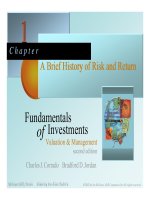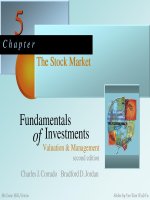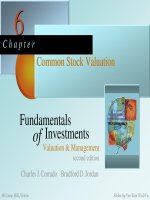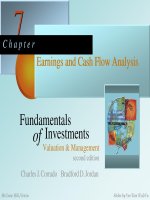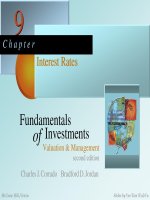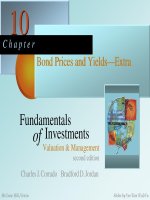Slides_Fundamentals of Investments - Chapter 19 potx
Bạn đang xem bản rút gọn của tài liệu. Xem và tải ngay bản đầy đủ của tài liệu tại đây (532.67 KB, 27 trang )
19
19
C h a p t e r
Performance Evaluation and
R
isk Management
Performance Evaluation and
R
isk Management
second edition
Fundamentals
of
Investments
Valuation & Management
Charles
J.
Corrado Bradford
D.Jordan
McGraw Hill / Irwin Slides by Yee-Tien
(Ted) Fu
© 2002 by The McGraw-Hill Companies, Inc. All rights reserved.
McGraw Hill / Irwin
19 - 2
It is Not the Return On
My Investment
“It is not the return on my investment
that I am concerned about.
It is the return of my investment!”
–
Will Rogers
© 2002 by The McGraw-Hill Companies, Inc. All rights reserved.
McGraw Hill / Irwin
19 - 3
Performance Evaluation & Risk Management
Our goal in this chapter is to examine
the methods of c evaluating risk-
adjusted investment performance,
and d assessing and managing the
risks involved with specific
investment strategies.
Goal
© 2002 by The McGraw-Hill Companies, Inc. All rights reserved.
McGraw Hill / Irwin
19 - 4
Performance Evaluation
Can anyone consistently earn an “excess”
return, thereby “beating”
the market?
Performance evaluation
Concerns the assessment of how well a
money manager achieves a balance between
high returns and acceptable risks.
© 2002 by The McGraw-Hill Companies, Inc. All rights reserved.
McGraw Hill / Irwin
19 - 5
Performance Evaluation Measures
The raw return on a portfolio, R
P
, is the total
% return on the portfolio with no adjustment
for risk or comparison to any benchmark.
It is a naive measure of performance
evaluation that does not reflect any
consideration of risk. As such, its usefulness is
limited.
© 2002 by The McGraw-Hill Companies, Inc. All rights reserved.
McGraw Hill / Irwin
19 - 6
Performance Evaluation Measures
The Sharpe Ratio
The Sharpe ratio is a reward-to-risk ratio that
focuses on total risk.
It is computed as a portfolio’s risk premium
divided by the standard deviation for the
portfolio’s return.
p
fp
σ
RR
−
=ratio Sharpe
© 2002 by The McGraw-Hill Companies, Inc. All rights reserved.
McGraw Hill / Irwin
19 - 7
Work the Web
Visit Professor Sharpe at:
/>© 2002 by The McGraw-Hill Companies, Inc. All rights reserved.
McGraw Hill / Irwin
19 - 8
Performance Evaluation Measures
The Treynor
Ratio
The Treynor ratio is a reward-to-risk ratio that
looks at systematic risk only.
It is computed as a portfolio’s risk premium
divided by the portfolio’s beta coefficient.
p
fp
RR
β
ratioTreynor
−
=
© 2002 by The McGraw-Hill Companies, Inc. All rights reserved.
McGraw Hill / Irwin
19 - 9
Performance Evaluation Measures
Jensen’s Alpha
Jensen’s alpha is the excess return above or
below the security market line. It can be
interpreted as a measure of how much the
portfolio “beat the market.”
It is computed as the raw portfolio return less
the expected portfolio return as predicted by
the CAPM.
(
)
[
]
{
}
β
fMpfpp
RRERR
−
×
+
−
=
α
© 2002 by The McGraw-Hill Companies, Inc. All rights reserved.
McGraw Hill / Irwin
19 - 10
Performance Evaluation Measures
© 2002 by The McGraw-Hill Companies, Inc. All rights reserved.
McGraw Hill / Irwin
19 - 11
Comparing Performance Measures
© 2002 by The McGraw-Hill Companies, Inc. All rights reserved.
McGraw Hill / Irwin
19 - 12
Comparing Performance Measures
Sharpe ratio
Appropriate for the evaluation of an entire
portfolio.
Penalizes a portfolio for being undiversified,
since in general, total risk ≈ systematic risk
only for relatively well-diversified portfolios.
Since the performance rankings may be
substantially different, which
performance measure should we use?
© 2002 by The McGraw-Hill Companies, Inc. All rights reserved.
McGraw Hill / Irwin
19 - 13
Comparing Performance Measures
Treynor ratio / Jensen’s alpha
Appropriate for the evaluation of securities or
portfolios for possible inclusion in a broader or
“master” portfolio.
Both are similar, the only difference being that
the Treynor ratio standardizes everything,
including any excess return, relative to beta.
Both require a beta estimate (and betas from
different sources may differ a lot).
© 2002 by The McGraw-Hill Companies, Inc. All rights reserved.
McGraw Hill / Irwin
19 - 14
Work the Web
The performance measures we have
discussed are commonly used in the
evaluation of mutual funds. See, for
example, the Ratings and Risk for
various funds at:
© 2002 by The McGraw-Hill Companies, Inc. All rights reserved.
McGraw Hill / Irwin
19 - 15
Sharpe-Optimal Portfolios
A funds allocation with the highest possible
Sharpe ratio is said to be Sharpe-optimal.
To find the Sharpe-optimal portfolio, consider
the plot of the investment opportunity set of
risk-return possibilities for a portfolio.
Expected
Return
Standard deviation
×
×
×
×
×
×
×
×
×
×
×
×
×
×
×
×
© 2002 by The McGraw-Hill Companies, Inc. All rights reserved.
McGraw Hill / Irwin
19 - 16
Expected
Return
Standard deviation
×
A
R
f
(
)
A
fA
RRE
σ
slope
−
=
Sharpe-Optimal Portfolios
The slope of a straight line drawn from the
risk-free rate to a portfolio gives the Sharpe
ratio for that portfolio.
Hence, the portfolio on the line with the
steepest slope is the Sharpe-optimal portfolio.
© 2002 by The McGraw-Hill Companies, Inc. All rights reserved.
McGraw Hill / Irwin
19 - 17
Sharpe-Optimal Portfolios
© 2002 by The McGraw-Hill Companies, Inc. All rights reserved.
McGraw Hill / Irwin
19 - 18
Sharpe-Optimal Portfolios
Notice that the Sharpe-optimal portfolio is one
of the efficient portfolios on the Markowitz
efficient frontier.
© 2002 by The McGraw-Hill Companies, Inc. All rights reserved.
McGraw Hill / Irwin
19 - 19
Investment Risk Management
We will focus on what is known as the Value-
at-Risk approach.
Investment risk management
Concerns a money manager’s control over
investment risks, usually with respect to
potential short-run losses.
© 2002 by The McGraw-Hill Companies, Inc. All rights reserved.
McGraw Hill / Irwin
19 - 20
Value-at-Risk (VaR)
If the returns on an investment follow a normal
distribution, we can state the probability that a
portfolio’s return will be within a certain range
given the mean and standard deviation of the
portfolio’s return.
Value-at-Risk (VaR)
Assesses risk by stating the probability of a
loss a portfolio may experience within a
fixed time horizon.
© 2002 by The McGraw-Hill Companies, Inc. All rights reserved.
McGraw Hill / Irwin
19 - 21
Value-at-Risk (VaR)
Example: VaR
Suppose you own an S&P 500 index fund.
Historically, E(R
S&P500
) ≈ 13% per year, while
σ
S&P500
≈ 20%. What is the probability of a return of -7% or
worse in a particular year?
The odds of being within one
σ
are about 2/3 or .67.
I.e. Prob (.13–.20 ≤ R
S&P500
≤ .13+.20) ≈ .67
or Prob
(–.07 ≤
R
S&P500
≤
.33) ≈
.67
So, Prob (R
S&P500
≤ –.07) ≈ 1/6 or .17
The VaR statistic is thus a return of –.07 or worse
with a probability of 17%.
© 2002 by The McGraw-Hill Companies, Inc. All rights reserved.
McGraw Hill / Irwin
19 - 22
Work the Web
Learn all about VaR at:
© 2002 by The McGraw-Hill Companies, Inc. All rights reserved.
McGraw Hill / Irwin
19 - 23
More on Computing Value-at-Risk
Example: More on VaR
For the S&P 500 index fund, what is the probability
of a loss of 30% or more over the next two years?
2-year average return = 2×.13 = .26
1-year σ
2
= .20
2
= .04. So, 2-year σ
2
= 2×.04 = .08.
So, 1-year σ
= √.08 ≈
.28
The odds of being within two
σ
’s are .95.
I.e. Prob
(.26–2×.28 ≤
R
S&P500
≤
.26+2×.28) ≈
.95
or Prob
(–.30 ≤
R
S&P500
≤
.82) ≈
.95
So, Prob (R
S&P500
≤ –.30) ≈ 2.5%
© 2002 by The McGraw-Hill Companies, Inc. All rights reserved.
McGraw Hill / Irwin
19 - 24
More on Computing Value-at-Risk
In general, if T is the number of years,
(
)
(
)
TRERE
pTp
×
=
,
T
pTp
×=σσ
,
So,
(
)
(
)
()
()
()
()
%5σ645.1Prob
%5.2σ96.1Prob
%1σ326.2Prob
,
,
,
=×−×≤
=×−×≤
=×−×≤
TTRER
TTRER
TTRER
ppTp
ppTp
ppTp
© 2002 by The McGraw-Hill Companies, Inc. All rights reserved.
McGraw Hill / Irwin
19 - 25
Work the Web
Learn about the risk management
profession at:
